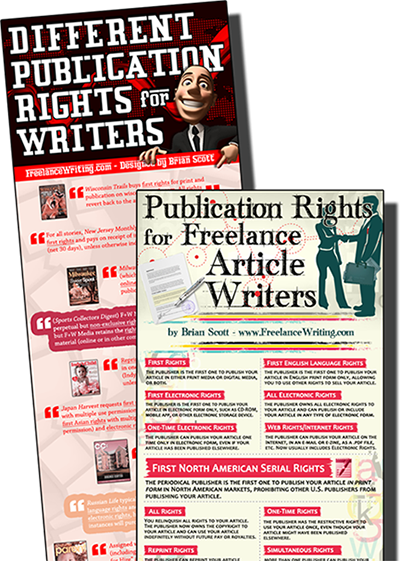Besides negotiating rates with editors to maximize what they pay for your articles, you might also need to negotiate the rights to your articles. In calculating a rate to pay for articles—such as feature articles or sidebars—editors also consider if the article is exclusive, an original first-print, a reprint, etc. , and the medium (print, digital, or both).
The type of rights that you license to editors can make a pay rate of .50 cents/word seem much smaller if editors demand exclusive worldwide rights in both print and electronic media, including archival rights, for your articles. Basically, you are relinquishing rights to license reprint rights or other licensing rights to earn additional income from non-competing markets.
Here is list of common publication rights that you will encounter when selling articles. I have listed them individually, even though editors will often combine some of these rights. For example, an editor might ask for “First Rights” to your article, but might also add “serial” and “electronic” rights.
Because I am not a legal expert, I encourage you to do your own research before you enter into a contract or publishing agreement with editors. In addition to this article, I also offer two free infographics at the end.
First rights
The publisher is the first one to publish your article. Since First Rights does not specify a medium or location, the publisher might choose to buy first rights for print media or digital media, or both.
First North American Serial Rights (FNASR)
The periodical publisher is the first one to publish your article in print form in North American markets, prohibiting other U.S. publishers from publishing your article. However, you can still sell rights to your article to publishers outside of the U.S. After the periodical publisher has published your article, all rights return to you. You can then resell your article to another publisher with different rights, but no longer with FNASR.
First English Language Rights
The publisher is the first one to publish your article in the English language, allowing you to use other rights to license your article. Since many U.S. publishers translate and distribute their publications outside of North America, you have the opportunity to sell your article in a different language at the same time.
First Electronic Rights
The publisher is the first one to publish your article in electronic form only. This may include CD-ROM, in an eBook, as part of a video, a digital PowerPoint presentation, in some form of broadcast media, etc. The publisher is not allowed to publish your article in print form. Publishers may consider Electronic Rights to include Internet Rights, which permits them to publish your article online as well.
All Electronic Rights
The publisher owns all electronic rights to your article and can publish or include your article in any type of electronic form, such as CD-ROMs. These rights may also include the Internet as a form of digital media. The publisher is forbidden to use your article in any print media.
One-Time Electronic Rights
The publisher can use your article one time in electronic form only, even if your article has been published elsewhere online. You can continue to license your article to other publishers with these rights.
Web Rights/Internet Rights/Digital Rights
Different than Electronic Rights, these rights allow the publisher to publish your article on the Internet only or in e-mail form. The publisher is forbidden to publish your article in electronic form such as on a CD-ROM or other electronic storage media. ** Publishers may classify Internet Rights to include or to mean Electronic Rights, so always ask.
All Rights
You relinquish all rights to your article. The publisher now owns the copyright to your article and can use your article indefinitely without future pay or royalties. You can no longer license other rights to this article, and you may be forbidden to include your article as a sample of work in a portfolio. You can, however, re-slant and rewrite this article and create a new piece of work from it.
Exclusive Rights
Your article cannot appear elsewhere during a specific timeframe as set forth by the publisher. For example, if you sell exclusive rights to an article, you cannot license rights to other publishers until the timeframe expires. You can negotiate with the publisher if you are licensing Exclusive Rights for print, electronic, or both.
Nonexclusive Rights
The opposite of the above. You can sell the article to more than one publisher at any time, as long as none of the publishers ask for exclusivity.
One-Time Rights
The publisher has the restrictive right to use your article once, even though your article might have been published elsewhere. You can license One-Time Rights to more than one publisher at a time, though not simultaneously. Many writers license FNAR to their articles first, and then license One-Time Rights to non-competing publications.
Reprint Rights or Second (Serial) Rights
The publisher can reprint your article which has been published previously by a different publisher. If a publisher asks for “exclusive reprint rights,” then you cannot sell the same article as a reprint ever again. Many publishers regard self-published articles (in print or digital form) as previously published material.
Simultaneous Rights
More than one publisher can publish your article at the same time. Although most publishers in similar and different markets avoid buying articles with Simultaneous Rights because they want exclusivity, some publishers may want to print your article in more than one periodical that they publish.
Excerpt Rights
The publisher can publish a section or portions of your article. For example, a textbook publisher might want to use a section of your article to include in its next textbook
edition, or use an excerpt to enhance its training manuals. Periodical publishers, like newspapers, commonly buy Excerpt Rights to publish excerpts from new novels written by well-known authors. Excerpt Rights does not infringe on First Serial Rights.
Anthology Rights
A publisher can publish your article in a specific anthology or as part of a compilation of material. For example, a publisher that had previously published your article may later ask for Anthology Rights to reprint your article in a special one-time periodical or anthology. Or a different publisher, having seen your article published elsewhere, may want to buy Anthology Rights to include your article in its own anthology or special periodical.
Archival Rights
The publisher has the right to archive your article, making your work accessible indefinitely to readers. These type of rights are common with publishers who wish to archive your article online at its website or in a database for future reading or research purposes. As long as your article is archived, it is considered still in print, preventing you to sell it elsewhere. If a publisher asks for Archival Rights, negotiate a time expiration. For example, permit the publisher to archive your article for up to one year, after which the rights revert to you.
International Rights
A publisher outside of your country can publish your article in the language in which you wrote your article, as well as translated versions of it. For example, a writer who lives in the U.S. can license his or her article with FNASR, while simultaneously licensing the article to publishers outside of the U.S., without infringing on other rights.
Worldwide Rights
The publisher can publish your article or book in other languages in all countries, not just one foreign country.
Work-for-Hire Agreement
The publisher as the employer hires you like an employee to write an article. Because U.S. copyright laws recognize the employer, not the employee,
as the legal author of the “work made for hire,” you cannot claim ownership of the finished article, nor retain copyright to the article. Because this agreement categorizes you as a temp. employee, the employer can claim the work as his own, use it as his own, and not give you credit, a byline, or future payment or royalties.
First Serial Rights (books)
The periodical publisher is the first one to publish excerpts of your book in print form in an issue before its official book release date. After your book excerpts are published by the periodical, all rights return to you but you cannot sell First Serial Rights a second time.
Subsidiary Rights (books)
The publisher can publish your book in other formats besides hardcover or paperback. This may include film, screenplay, video, audio, and/or foreign language formats. Additionally, Subsidiary Rights may also include both print and electronic rights, first or second serial rights, anthology rights, and so on.
Free Infographics:
You can view these two infographics in large size at our site. The first infographic is called “Publication Rights for Freelance Article Writers”—a visual translation of this article. The second infographic is called “Different Publication Rights for Writers”—it reveals “publication rights” at specific magazines. To grab our infographics for your own site or to use them as you wish, visit our Pinterest page and save the infographics to your computer or mobile device.




